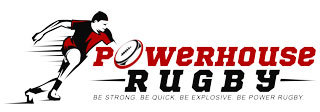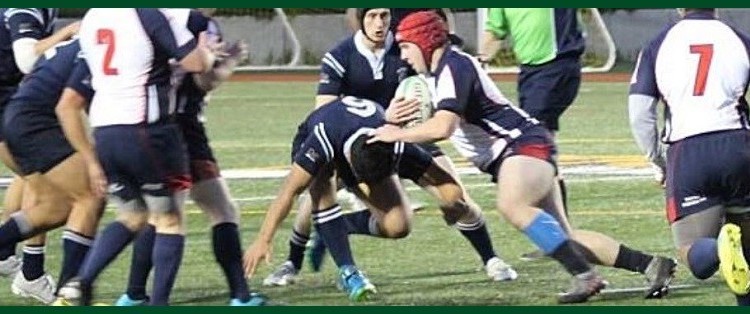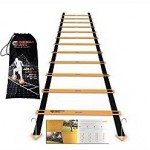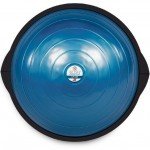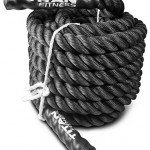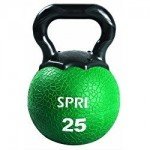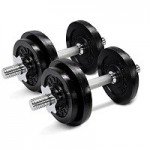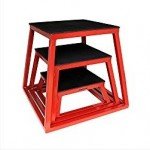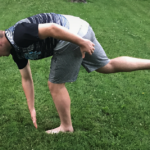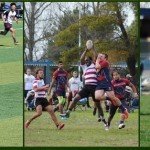11 Great Rugby Player Training Drills to Improve Balance
Years ago, I was watching a group of rugby players playing touch. I noticed a few of the players were better at balancing their bodies. Many of the players tumbled to the ground when they’d swerve away from an opponent on the field. With a just a slight lean of their body, they landed on the ground.
Except, there was this one player, who stood out from all the rest with his amazing balance abilities. He made cuts using his body in a horizontal lean towards the ground, and yet, he was able to keep his feet stable–never falling to the ground.
After the ruggers finished their game, I approached this young man to ask him if did anything special to work on his balance. He told me he was not a naturally-gifted athlete. As a child in school, he was considered pudgy and clumsy. He confessed that he was “that fat kid” who was picked last by teams. To change this, he decided to begin a workout program and target his workout on improving his balance and explosiveness.
Research balance and its impact on athletes
I decided to read as much as I could find on the subject of improving balance. I watched numerous videos of elite athletes in action. I recognized how balance is a learned skill that you can bolster–much like how you learn to kick a ball better. You can improve your balance with training and practice. Balance exercises or drills are those that place an athlete in an unstable position to challenge the body’s sense of balance. The brain is always analyzing the body’s position while making adjustments to keep the body in an upright position. You can improve and quicken that interaction between the brain and the body over balance.
Having good balance allows rugby players to react quickly to the always-changing physical demands in a rugby game. Good balance ensures that the body remains in an athletic position, ready to make quick reaction plays and protect the body from injury. Not only is balance training necessary for all rugby players but it also improves coordination and posture, so players also don’t get hurt when goofing around in their everyday lives. Yes, rugby players do goof around in their daily lives. Shocking, I know.
How Do Rugby Players Improve Balance?
Ruggers can improve balance by performing drills that challenge the body’s sense of balance. These drills are called, “Controlled Instability Exercises.”
The rugby players I have coached understand that I am an insane advocate of 1-legged drills. I consistently have players perform this activity in training because it not only makes ruggers more explosive, but it challenges the body’s sense of balance while strengthening the legs. Also if you have a weaker side, you need to work to balance your body to prevent injury. For example, your left arm is weaker than your right arm, by working your arms independent of each other this will allow your left arm to gain strength and not have your right arm take over and dominate the drills.
11 Rugby Player Exercises to Improve Balance
The equipment you’ll need:
• Training Ladder (Substitution – placing boxes in a line on the ground 15 inches apart, or draw lines, or laying down sticks).
• BOSU Ball (Substitution – pillows).
• Kettlebell or Dumbbells (Substitution – Fill bags with sand to create sandbags & weight them).
• Sliders (Substitution – Towels or wash rags).
1. Training Ladder Exercise.
Ladder agility training improves how quickly your muscles contract, develops your standing balance and your balance while you’re in motion, and enhances your body’s reaction speed.
How to Perform:
• On right leg up on the balls of your feet, hop on one foot moving forward keeping your back upright and straight.
• Then do the same with the other leg.
• Hop back and forth on one foot moving forward down the line.
• Sets/Reps: 3 sets – 5 – 8 reps.
2. BOSU Ball Squats with Weights Exercise.
Squats are great for strengthening the glutes, quadriceps, and your core. Adding weight and performing them on a BOSU ball will increase your strength, balance, and stabilization. Performing this exercise on a regular basis will transition to the rugby field by making you more efficient during a game.
How to Perform:
• Place a BOSU ball in front of you with the flat side up, and the round side is touching the floor.
• Step onto the BOSU ball and adjust your footing until your feet are shoulder-width apart.
• Perform a standard Squat, lowering yourself to 90 degrees, keeping your back, knees, and toes straight and your core tight.
• Sets/Reps: 3 x 10.
3. BOSU Ball Single-Leg Star Squats.
This leg squat is one of my favorite balance exercises because it makes the quadriceps burn. Performing Single-Leg Squats prevents your dominant leg from doing more work over your weaker leg. The exercise also better simulates in-game motions, because usually you are running or jumping off of one foot in rugby.
How to Perform:
• Place a BOSU ball in front of you with the flat side up, and the round side is touching the floor.
• Step onto the BOSU ball with one foot right in the center of the ball.
• Perform a Squat on one leg with your other leg out to the side.
• After one repetition, perform another Squat on the same leg with your free leg directly behind you.
• After one repetition, perform a Curtsy Squat on that same leg with your free leg behind you at an angle. That is one full repetition.
• Sets/Reps: 3 x 10 on each leg.
4. BOSU Ball Battle Ropes.
This exercise forces you to focus on maintaining balance while resisting movement, which is beneficial for in-game situations because unless you’re a goalie, you rarely stand in one spot without moving. This Bosu exercise will also increase your upper-body and core strength.
How to Perform:
• Set up battle ropes by wrapping them around a pole or post.
• Place a BOSU ball in front of the ends of the battle ropes with the flat side up and with the round side is touching the ground.
• Step onto the BOSU ball and adjust your feet until they are shoulder-width apart.
• Pick up the battle ropes, one rope in each hand.
• Get into a partial squat position, about 45 degrees.
• Alternate moving the battle ropes up and down using your arms and core while maintaining your balance.
• Progress to a single leg as you get stronger.
• Sets/Duration: 3 x @30 seconds.
5. BOSU Ball Ski Moguls.
These combine movement with balancing primarily in the lower body. They are very popular among downhill skiers because they train the legs to be stable and balanced when resisting hills.
How to Perform:
• Place a BOSU ball in front of you with the flat side up, and the round side is touching the floor.
• Step onto the BOSU ball and adjust your feet until they are shoulder-width apart.
• Squat down to about 90 degrees.
• Press one foot toward the floor, then quickly raise it as you lower your other foot. You are rocking side to side.
• Sets/Duration: Repeat rapidly, counting both feet as one repetition until you aren’t able to complete them anymore.
6. Single-Leg Roman Dead Lift With Row.
This balance exercise is a compound movement that trains both the upper and lower body to maintain balance. It requires coordination and stabilization for your muscles to work together to act, as seen in any athletic movement.
How to Perform:
• Grab a dumbbell or kettlebell that is a lighter weight.
• Hold the weight in your left hand and stand on your right leg at the same time.
• Perform a Romanian Deadlift, making sure to keep your back, knee and toe straight and your core tight.
• At the bottom of the RDL, pause and perform a Single-Arm Row. Pull the weight toward your hip, keeping your elbow in close as you flex your back, bend your arm and bring your shoulder upward. At the top, your elbow should be pointed toward the ceiling as you squeeze your shoulder blades together. Lower the dumbbell/kettlebell under control along the same path. Complete your reps on one side, then switch arms and do the same amount of reps for the other — that’s one set.
• Come back up to the starting position.
• As you grow stronger, up your progress by performing this exercise on a BOSU ball.
• Sets/Duration: 3 Sets – 5 – 8 reps.
7. Single-Leg Roman Dead Lift With Press.
This exercise creates the same benefits as the previous exercise, but the Press focuses on strengthening the shoulders and triceps. This exercise primarily helps athletes in sports requiring overhead movements.
How to Perform:
• Grab a dumbbell or kettlebell that is a lighter weight.
• Hold the weight in your left hand and stand on your right leg at the same time.
• Perform a Romanian Deadlift, making sure to keep your back, knee and toe straight and your core tight.
• At the top of the RDL, pause and perform a Single-Shoulder Press.
• Perform another RDL.
• As you grow stronger, increase the intensity by performing this exercise on a BOSU ball.
• Sets/Reps: 3 x 10 on each leg.
8. BOSU Ball Pistol Squats
This exercise targets your quadriceps. It also activates the core and just about every other muscle in the lower body, including the glutes, hamstrings, and calves. It is ideal for athletes who perform movements primarily on one leg.
How to Perform:
• Place a BOSU ball in front of you with the flat side up, and the round side is touching the floor.
• Step onto the BOSU ball with one foot in the center of the ball.
• Stand holding your arms straight out in front of your body at shoulder level, parallel to the floor.
• Perform a standard Squat to 90 degrees, making sure not to let your knee cave in or out.
• Progress by adding weight via dumbbells, weighted vest, barbell or EZ Curl Bar.
• Sets/Reps: 3 x 10 for each leg.
9. Slider Reverse Lunge.
This exercise requires great balance and quadriceps strength because your foot is on a slick surface. The Lunge is an overall great exercise for strengthening the core, which is essential for maintaining balance.
How to Perform:
• Place a slider behind you, or use a towel on a slick surface.
• Add weight via dumbbells, weighted vest, barbell or EZ Curl Bar.
• Get into a lunge position with your front foot off the slider and your back foot on the slider.
• Perform a Reverse Lunge, making sure to keep your back, knee and toe straight and your core tight.
• Use your forward leg to bring yourself back up, with minimal assistance from your back leg.
• Sets/Reps: 3 x 10 on each leg.
10. Slider Lateral Lunge.
This exercise offers benefits similar to the previous exercise, but it targets more of the inner thigh or adductor muscles in addition to the quadriceps. The variation in angle activates different stabilizer muscles, creating a more balanced athlete.
How to Perform:
• Place a slider by your side, or use a towel on a slick surface.
• Add weight via dumbbells, weighted vest, barbell or EZ Curl Bar.
• Get into a lateral lunge position with one foot off of the slider and the other foot on the slider.
• Perform a Lateral Lunge, making sure to keep your back, knee and toe straight and your core tight.
• Use your leg off the slider to bring yourself back up, with minimal assistance from your leg on the slider.
• Sets/Reps: 3 x 10 on each leg.
11. Leg-Elevated Bulgarian Split Squat.
The Lunge is an all-around great exercise. When you elevate your leg, you increase the difficulty by requiring more stabilizer muscles to activate. This exercise improves your ability to balance and increases your quadriceps strength.
How to Perform
• Place a bench or plyometric box behind you at about knee-high.
• Add weight via dumbbells, weighted vest, barbell or EZ Curl Bar.
• Lift one leg up and place it on the bench or box behind you.
• Perform a Standard Split squat, keeping your back, knee, and toe straight and your core tight.
• Sets/Reps: 3 sets on each leg – 5-8 Reps.
Include these balance training drills into your rugby training workouts three times a week. Also, pay attention to how your body uses balance during your waking hours. Notice how your feet land as you walk. Do you walk on the outside or inside of your arch? How do your heels hit the ground and roll to the balls of your feet? How is your stride? The more aware are of how your body’s balance impacts all of your movements throughout the day, the quicker you’ll notice the benefits of your balancing training even when you are not on a rugby field.
Be sure to take a moment to sign up for the Tryline Newsletter and follow this blog for more upcoming advice from my coach’s corner.
Get to it NOW.
Coach Terry
REMEMBER: Before starting any new exercise routines please check with your medical provider and clear your new exercise plan with them before beginning. This is especially true if you haven’t been exercising for some time or are recovering from an injury. I am not a doctor, nor do I play one on T.V.
![]()
Be sure to take a moment to sign up for the Tryline Newsletter and follow this blog for more upcoming advice from my coach’s corner.
Need help getting started towards your power rugby fitness goals?
The Powerhouse Rugby weekly newsletter seeks to supply you with the top rugby fitness drills, nutritional suggestions, and advice from coaches and players to help make your rugby goals a reality.
When you sign up for the newsletter, we’ll send you our free training guide and workout tracker which includes this exercise drill and more.
Click on the image to the left to sign up today!
